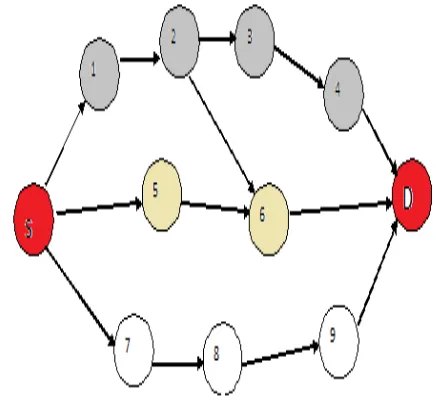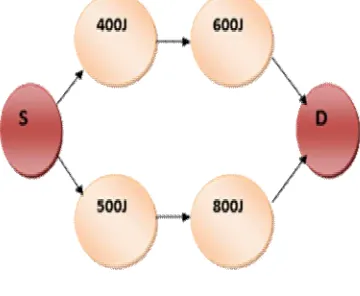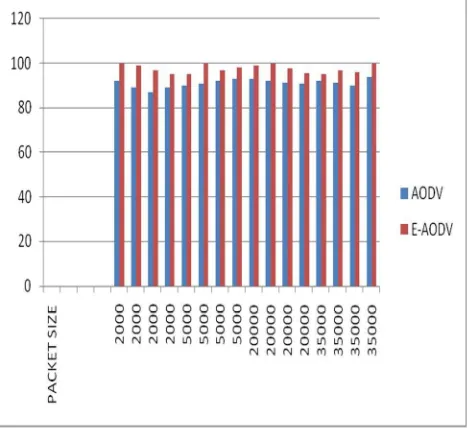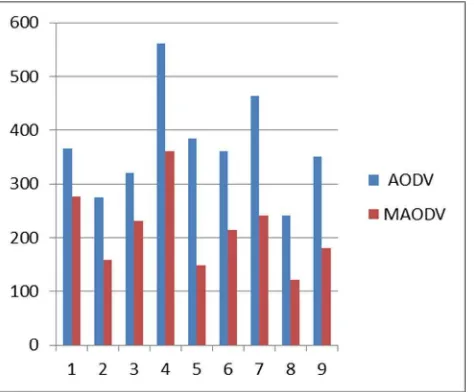Volume 4, Issue 4, July – August 2015 Page 69 find shortest and optimized path from a source to destination. Due to dynamic nature, connections in the network can change frequently and nodes can be added and removed at any time. There are various types of limitations; the biggest restriction is the limited energy of the batteries. AODV is one of famous on-demand routing protocols in MANET, which uses the RDP (route discovery process) is triggered to find a new route. In this paper, we propose that the enhanced AODV (Ad-hoc On-demand Distance Vector) routing protocol which is modified to improve the networks lifetime in MANET. Keyword: Mobile ad hoc network (MANET), Ad hoc on demand distance vector routing (AODV), Multipath, Route discovery process (RDP), network lifetime
1.
INTRODUCTION
Mobile Ad-Hoc network is a collection of mobile nodes which are free to move in any direction and change topology frequently. Nodes are behaving as host as well as router and maintain network transition without any fix infrastructure. [1][2], each node or router must forward the packets unrelated to its own use [3].
Main challenges to maintain the Mobile Ad-Hoc network are: No base station, limited power backup, continuously maintains the information due to mobility. Each node discovers the routing path by using route request and route reply packets [4]. This infrastructure less network is managed using the routing protocols. In MANET routing is the process of selecting paths in a network along which to send data or physical traffic. Routing is useful for delivering packets from
source to destination with the help of their logically addresses through intermediary nodes [5]. Every routing protocol has its own algorithm on the basis of which it ZRP etc. In the last few years, there are several researches have evaluated the performance of routing protocols for mobile Ad- Hoc network as a function of mobility rate and pause time [8] using ns2(network simulator 2).
2.
ROUTING PROTOCOLS
MANET is fully dynamic so routing protocols have very important role for searching and selecting the routes between source and destination today it is the most important fundamental research issue and must deal with limitations of mobile ad hoc network such as high power consumption, low bandwidth, high error rates and unpredictable movements of nodes[9]. Generally, current routing protocols for MANET can be categorized in many classes.
2.1 Proactive Routing (Table-Driven)
The pro-active routing protocols [10, 11] are the same as current Internet routing protocols such as the RIP (Routing Information Protocol), DV (distance-vector), OSPF (Open Shortest Path First) and link-state . They attempt to maintain consistent, up-to-date routing information of the whole network. Some of the existing pro-active ad hoc routing protocols are: OLSR (Optimized Link State Routing,) DSDV (Destination Sequenced Distance-Vector) etc.
2.2 Reactive Routing (Source-Initiated On-Demand Driven)
These protocols try to eliminate the conventional routing tables and consequently reduce the need for updating these tables to track changes in the network topology. When a source communicate with destination, it has to establish a route by route discovery procedure with the help of HELLO packet, then select the preferred route then route maintenance procedure until either the route is present, and finally route deletion procedure. Some of the existing re-active routing protocols are [12].DSR (Dynamic Source Routing), TORA (Temporally-Ordered Routing Algorithm), AODV (ad hoc On-Demand Distance Vector Routing).
Network Lifetime Improvement Using Energy
Efficient Multipath ad hoc on demand distance
vector routing
Madhvi Saxena1, Neha Jain2
1
Dr. K N Modi University, Department of Computer Science and Engineering, Niwai, Tonk Road, Raj, 304021, India
2
Volume 4, Issue 4, July – August 2015 Page 70 2.3 Hybrid Protocols
Hybrid routing protocols [13] is a combination of proactive and reactive protocol, aggregates a set of nodes into zones in the network topology. The network is divided into zones and proactive approach is used within the zone to maintain routing information and reactive approach for route packets between different zones.
3
OVERVIEW
OF
AODV
ROUTING
PROTOCOLS
AODV is an improvement on DSDV (Destination Sequenced Distance Vector) because it typically minimizes the number of required broadcasts by creating routes on an on-demand basis, as refuse to maintaining a total list of routes as in the DSDV algorithm. When source wants to send a data packet to some destination and does not have a direct route to that destination, it starts a path discovery process to discover the destination. It broadcasts a RREQ (route request) packet to its neighbor nodes; if destination node is not present then these nodes forward the request to their neighbors, and so on, until the destination is reachable. Then, the source node can send its packets to the destination via the established path [14]. A AODV routing protocol is an on demand distance vector routing which uses route request (RREQ), route reply (RREP), and route error (RERR) messages in the on-demand route searching process [15].
In the proposed MAODV algorithm, multiple paths are considered and the load is distributed uniformly by using the information available in the network. The main goal is to select a routing path that consists of nodes with remaining energy of higher order and hence providing longer life span in order to reduce routing overhead [16] and also to reduce the average end-to-end delay by routing the packets over the path which is less utilized.
4
ROUTING PROCESS
The routing process involved in any routing protocol is mainly classified into three main divisions:
•
Route Discovery•
Route Selection•
Route MaintenanceThe Route Discovery and Route Selection processes are modified for effectively implementing the load balancing features in proposed energy efficient Multi-Path AODV (MAODV) routing protocol.
4.1 Route Discovery
In this work the author has modified the route discovery process, keeping remaining features of the similar to Ad hoc On-demand Distance Vector routing (AODV) protocol. Whenever a source wants to send data packets to other nodes, it determines route available to reach that destination node in its routing table. If there is no established route between source and destination, it starts
the route discovery process by broadcasting Route Request (RREQ) packets to all the neighboring nodes (Ref fig 1).
Figure 1.Route Request in AODV
4.2 Route Selection
The route selecting parameters used in the modified multipath AODV (MAODV) are defined as follows:
4.2.1 Minimum Hop count
There always exists possibility of many intermediate nodes between source and destination, and the route of which has minimum number of hop count. Select that path as the best preferred path between sources to destination (Ref fig 2).
Figure 2. Hop Count in AODV
Route 1: S-1-2-3-4-D (4 hop count) (3rd preferred path)
Route 2: S-5-6-D (2 hop count) (1st preferred path)
Route 3: S-7-8-9-D (3 hop count) (2nd preferred path)
4.2.2 Route Energy
Volume 4, Issue 4, July – August 2015 Page 71 Figure 3.Route energy
Route 1: S-500j-800j-D (1st preferred path)
Route 2: S-400j-600j-D (2rd preferred path)
“If min hop count route has minimum energy or less then threshold value the skip those paths and move on second preferred path”.
4.2.3 Stability
The route has low rate of nodes mobility, if the mobility of nodes is less than the stability of route is higher.
4.3 Route Maintenance
In MANET, mobility of nodes is very high then link failure is a common phenomenon since mobile nodes moves out of its transmission range. Whenever link failure is depicted by an intermediate node, it broadcasts a Route Error (RERR) packet to other mobile nodes. When the source node receives the route error (RERR) packet, it immediately starts a new route discovery. This new route would be the alternative path from multipath identified above by the researcher for data transfer.
5
LOAD BALANCING
After the selection of multiple paths based on above concept(s) briefly described above; the important question now is how to distribute the load to these different paths. The researcher for balancing the load has incorporated the use of concept ‘First Come First Serve’.
In this proposed work; initially choose the best path and with the help of route selection transfer data packet on that path.
When load of the path increases or packet size became maximum then congestion is comes and packet delivery is decreased and packet drop is increases, then the overall performance is decreased.
If congestion of that path is increased then multipath technique for AODV is used. It means that data packets are transferred on more than one selected path with the help of ‘First Come First Serve’ technique.
6
SIMULATION SETUP
There are many network simulators are present here Network Simulator (NS) 2 used for Simulating, modeling and analyzing the performances of MAODV algorithm with the standard AODV Algorithm.
Software Requirements: Operating System: RHEL Linux
Development Environment: Virtual Machine (VMware workstation)
Network Simulator: NS2
Table 1: Parameter values
PARAMETERS VALUE(s)
Simulation Time 360Nodes
Protocol used AODV and MAODV
Area 100*100
Traffic TCP/FTP
Channel Wireless
Operation mode 802.11
7
ALGORITHM FOR PATH SEARCH
Start ()
For I= 0 to n // n number of nodes
Begin
Route Discovery process () {
Route request -> R [1], R [2], R [3]…….R [N]; // Send Request to all possible nodes
Receive Route Reply packet (); //These paths are possible }
Route Selection Process () {
Select (minimum Hop counts && maximum energy routes);
R [E] -> EN [1] +EN [2] +EN [3] +……..+EN[n]; }
Data transfer () {
//Use First Come First serves technique; P[1]-> 1st selected path;
}
If conjunction >= Threshold value Multipath ()
{
Volume 4, Issue 4, July – August 2015 Page 72 P [3] -> 3rd selected path;
} End;
//Repeat until all the data is transferred using energy efficient multipath approach.
Table 2: Improvements in Network lifetime
8
MAX NETWORK LIFETIME
Energy is a very critical issue in MANET, so that in this paper, author work on energy efficiency or for improvement of network lifetime. The process of selecting energy efficient path and for increases the network lifetime is discussed above in detail, here the author shows the improved results in MAODV algorithm as compared with AODV routing protocol. Max Energy Level shows that nodes required lesser energy to complete communication.
For the parameter Max_Energy a Simulation has been done on scenario of network 25 nodes on standard AODV and MAODV the data is shown in table 2. The data reveals that was collected on four different packet sizes 2000 MB, 5000MB, 20000 MB, 35000MB and calculate remaining energy of different paths on AODV and MAODV algorithm with the help of trace files which generated in NS2 simulator.
Fig 4 is the graphical representation of network lifetime of paths or we can say remaining energy of paths of 25 nodes network. An analysis by seen this graph can
be drawn that MAODV algorithm provides higher network life time than standard AODV algorithm.
Figure 4. Improvement in Increase of Network life time
9
AVERAGE END TO END DELAY
For the parameter Average End-to-End Delay a Simulation has been done on scenario of network 25 nodes on standard AODV and MAODV the data is shown in table III. The data reveals that was collected on three different packet sizes.
On the basis of Table III an analysis for 25 nodes Scenario is done between AODV and MAODV for Packet size on different speeds. Improvements are calculated on various packet size and on scenario which shows Average End-to-End Delay is lesser in MAODV over AODV in 25 nodes network
Table 3: Minimization of average end to end delay Pack
et Size
No of Path
Average End-to-End
Delay in AODV
Average end to end
delay in MAODV
IMPROVE MENT
2000 1:1 366.23 275.77 90.46
2000 1:2 275.70 157.95 117.75
2000 1:2:3 319.91 230.53 89.38
5000 1:1 662.08 360.87 301.21
5000 1:2 384.59 149.09 235.5
5000 1:2:3 360.89 214.76 146.13
2000
0 1:1 664.00
240.81 423.19
2000
0 1:2 240.81
120.87 119.94
2000
0 1:2:3 350.80
Volume 4, Issue 4, July – August 2015 Page 73 Figure 5 is the graphical representation of average end to
end delay of 25 nodes network. This graph shows the performance of AODV and MAODV with 25 nodes network. An analysis by seen this graph can be drawn that MAODV provides efficient Lesser of Average End-to-End Delay than standard AODV algorithm.
Figure 5 Lesser no of packet dropped in MAODV
10
CONCLUSION
In this paper an approach is developed to a network using Energy efficient multipath load balancing. By applying MAODV a new approach is developed by modifying the standard of AODV routing protocol.
By selecting energy efficient path in the algorithm reduces broadcasting of the packet so, energy of the network gets consumed and it provides energy efficient network. And addition and deletion of nodes in the network affects the performance of the network so, this approach helps to provide good scalability of the network. MANET is the network which has Energy consumption problem due to power drainage of batteries. On that basis an analysis is done and found that MAODV is better than AODV
References
[1] Nadia Qasim, Fatin Said, Hamid Aghvami ,” Mobile Ad Hoc Networks Simulations Using Routing Protocols for Performance Comparisons”, Proceedings of the World Congress on Engineering 2008 Vol I WCE 2008, July 2 - 4, 2008, London, U.K.
[2] S. R. Das, R. Castaneda, J. Yan, R. Sengupta, “Comparative Performance Evaluation of Routing Protocols for Mobile Ad hoc Networks”, Proceedings of the International Conference on Computer Communications and Networks, pp.153-161, 1998. [3] Bulent Tavli “Mobile Ad Hoc Networks:
Energy-Efficient Real-Time Data Communications”, 2006 [4] Azzedine Boukerche “Algorithms and Protocols for
Wireless, Mobile Ad Hoc Networks”, 2008
[5] Asma Tuteja, Comparative Performance Analysis of DSDV, AODV and DSR Routing Protocols in
MANET using NS2, 2010 International Conference on Advances in Computer Engineering.
[6] Shaily Mittal, PERFORMANCE COMPARISION OF AODV, DSR and ZRP ROUTING PROTOCOLS IN MANET’S, 2009 International Conference on Advances in Computing, Control, and Telecommunication Technologies
[7] Mohammad llyas,Richard C. Dorf “The handbook of ad hoc wireless networks”, 2003
[8] Performance Evaluation of Secure on-Demand Routing Protocols for Mobile Ad-hoc Networks Junaid Arshad Mohammad Ajmal Azad Department of Computer Engineering Department of Telecom Engineering FAS, IIUI
[9] Pakistan FAS, IIUI Pakistan 15th IEEE International Conference on Network Protocols, Beijing, China. 2007.
[10]Priyanka Goyal1 , MANET: Vulnerabilities, Challenges, Attacks, Application, IJCEM International Journal of Computational Engineering & Management, Vol. 11, January 2011
[11]Belding-Royer,E.M. and C.K. Toh, 1999. A review of current routing protocols for ad-hoc mobile wireless networks.IEEE Personal Communication magazine pp:46-55.
[12]M. royer and c-k toh , ―a review of current routing protocols for ad hoc mobile wireless
[13]M. Frodigh, P. Johansson, and P. Larsson.―Wireless ad hoc networking: the art of networking without a network,‖ Ericsson Review,No.4, 2000, pp. 248-263 [14]N. Kumar, Power Aware Routing Protocols in Mobile
Adhoc Networks-Survey, © 2012, IJARCSSE All Rights Reserved
[15]Perkins and P. Bhagwat, “Highly dynamic Destination- Sequenced Distance Vector routing (DSDV) for mobile computers,” in ACM SIGCOMM, Oct. 1994.
[16]Shaily Mittal1, “PERFORMANCE COMPARISION OF AODV, DSR and ZRP ROUTING PROTOCOLS IN MANET’S” 2009 International Conference on Advances in Computing, Control, and Telecommunication Technologies.
AUTHOR
Madhvi Saxena received the B.E. and M.Tech. degrees in Computer Science and Engineering from RGPV University in 20011 and 2014



